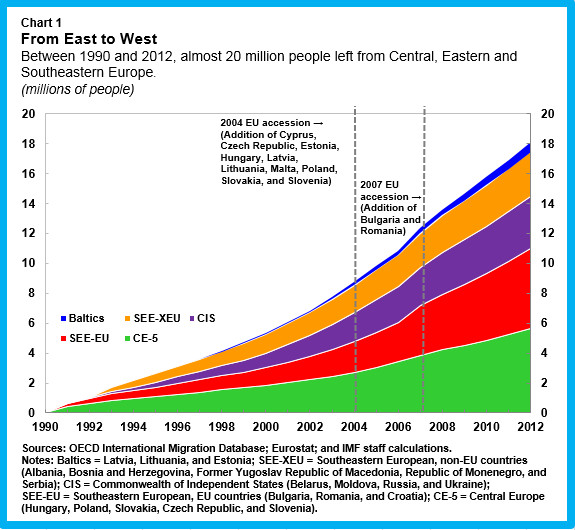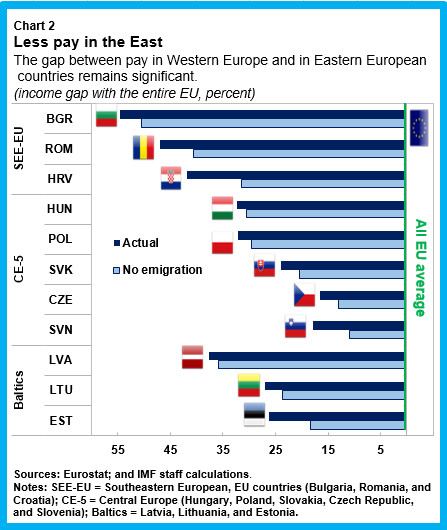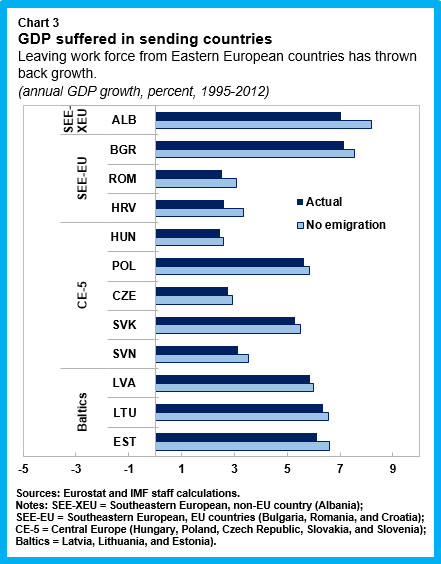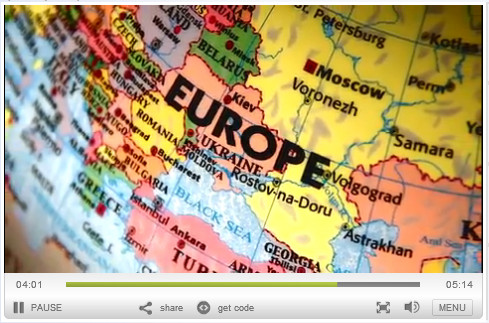The opening up of Eastern Europe to the rest of the world in the early 1990s brought about tremendous benefits. The inflow of capital and innovation has led to better institutions, better economic management, and higher efficiency. On the flip side, it has also led to sizable and persistent outflow of people.
Close to 20 million, mostly young and skilled Eastern Europeans—equal to the combined population of the Czech Republic and Hungary—left their countries over the past 25 years to seek better opportunities abroad (Chart 1). And even as they have contributed to the riches of the receiving countries and the EU as a whole, their departure has slowed growth and convergence of their home countries to the living standards of advanced Europe. A study by IMF staff proposes policy options to balance the scales.  Emigration slowed growth in Eastern Europe Economic migration is driven by personal choices. For Eastern Europeans, the motivation to leave is mainly better jobs and higher pay (Chart 2). Many of these economic migrants are highly skilled (e.g., doctors, architects, engineers) and younger than the average person at home. The less effective the government and the weaker the institutions (guarding the rule of law, upholding accountability and fighting corruption) in their home countries, the more likely the young and educated are to seek better opportunities abroad. While emigrants themselves tend to be better off and their families back home often benefit from remittances, their departure weakens the economic potential of their home countries.
Emigration slowed growth in Eastern Europe Economic migration is driven by personal choices. For Eastern Europeans, the motivation to leave is mainly better jobs and higher pay (Chart 2). Many of these economic migrants are highly skilled (e.g., doctors, architects, engineers) and younger than the average person at home. The less effective the government and the weaker the institutions (guarding the rule of law, upholding accountability and fighting corruption) in their home countries, the more likely the young and educated are to seek better opportunities abroad. While emigrants themselves tend to be better off and their families back home often benefit from remittances, their departure weakens the economic potential of their home countries.  This has left Eastern European countries worse off (Chart 3). Large and persistent emigration appears to have slowed both overall and per capita output growth rates. In the absence of emigration between 1995 and 2012, real GDP growth would have been altogether 7 percentage points higher on the average in the region, according to analytical work by IMF staff. Some skills are in short supply, lowering productivity growth in the East. And while the large inflow of remittances has supported investment and consumption, it also led to exchange rate appreciation, making economies less competitive. Moreover, the money sent back to relatives pushed up starting wages and reduced incentives to work. As a result, wages have risen faster than productivity, eroding returns on investment and weakening incentives to invest in home countries.
This has left Eastern European countries worse off (Chart 3). Large and persistent emigration appears to have slowed both overall and per capita output growth rates. In the absence of emigration between 1995 and 2012, real GDP growth would have been altogether 7 percentage points higher on the average in the region, according to analytical work by IMF staff. Some skills are in short supply, lowering productivity growth in the East. And while the large inflow of remittances has supported investment and consumption, it also led to exchange rate appreciation, making economies less competitive. Moreover, the money sent back to relatives pushed up starting wages and reduced incentives to work. As a result, wages have risen faster than productivity, eroding returns on investment and weakening incentives to invest in home countries.  With lower output, government spending on social benefits has increased in relation to GDP. The departure of the young adds to the already existing trend of the elderly occupying an increasing share in the population, leading to more spending on retirement benefits relative to GDP. Governments have tended to respond to these budgetary pressures by raising labor taxes that lower employers’ incentives to create jobs, thus making budgetary structure even less jobs and growth friendly. The departure of some of the youngest and brightest makes Eastern Europe’s process of catching up to advanced Europe more challenging. Boon for Europe as a whole How about the impact of the east-west migration on receiving countries? The westward migration seems to have contributed to stronger growth in Western European countries and been an economic boon for the European Union as a whole. As such, economic migration is an indicator of success of the European Union project, which sees freedom of movement as necessary for greater economic integration and, ultimately, higher incomes for all. With income and institutional differences between East and West remaining wide, the push and pull factors driving emigration from the east are likely to persist for some time. What’s more, the trends could further intensify with new countries getting ready to join the European Union. Making it work for all Overall, European Union membership brought substantial benefit for Eastern Europe. Now what can be done to ensure that the free flow of people leads to a win-win outcome for both labor sending and receiving countries? Although there are some tasks to be done locally, there is also room for a pan-European response.
With lower output, government spending on social benefits has increased in relation to GDP. The departure of the young adds to the already existing trend of the elderly occupying an increasing share in the population, leading to more spending on retirement benefits relative to GDP. Governments have tended to respond to these budgetary pressures by raising labor taxes that lower employers’ incentives to create jobs, thus making budgetary structure even less jobs and growth friendly. The departure of some of the youngest and brightest makes Eastern Europe’s process of catching up to advanced Europe more challenging. Boon for Europe as a whole How about the impact of the east-west migration on receiving countries? The westward migration seems to have contributed to stronger growth in Western European countries and been an economic boon for the European Union as a whole. As such, economic migration is an indicator of success of the European Union project, which sees freedom of movement as necessary for greater economic integration and, ultimately, higher incomes for all. With income and institutional differences between East and West remaining wide, the push and pull factors driving emigration from the east are likely to persist for some time. What’s more, the trends could further intensify with new countries getting ready to join the European Union. Making it work for all Overall, European Union membership brought substantial benefit for Eastern Europe. Now what can be done to ensure that the free flow of people leads to a win-win outcome for both labor sending and receiving countries? Although there are some tasks to be done locally, there is also room for a pan-European response.
- For Eastern Europe: better institutions and economic policies in home countries would make it more attractive for people to stay, for emigrants to return, and for people from other countries to seek jobs in Eastern Europe. Further liberalization of immigration regimes, especially for skilled workers, could be considered as well. Governments can do more to work with diasporas abroad in order to leverage their expertise and savings, and to provide more incentives for people to invest rather than spend remittances. In addition, more can be done to retain and better use the existing workforce, for example, through better matching of education to employment needs and providing more opportunities for on-the-job training. The choice of policy responses to emigration-related fiscal pressures matters as well: avoiding increases in labor taxes and relying more on consumption taxes would be more conducive for investment and long-run growth.
- For the European Union: given that the East-West migration has benefited the European Union as a whole, there is a case for better redistributing the gains. For example, the size and composition of the European Union structural and cohesion funds—transfers from wealthier to poorer European Union regions—could explicitly account for the negative effects of emigration on sending countries’ economic potential. This would also be consistent with the European Union’s goal of reducing economic and social disparities across regions and promoting sustainable development.
You can watch the video about Eastern Europe's emigration here 





